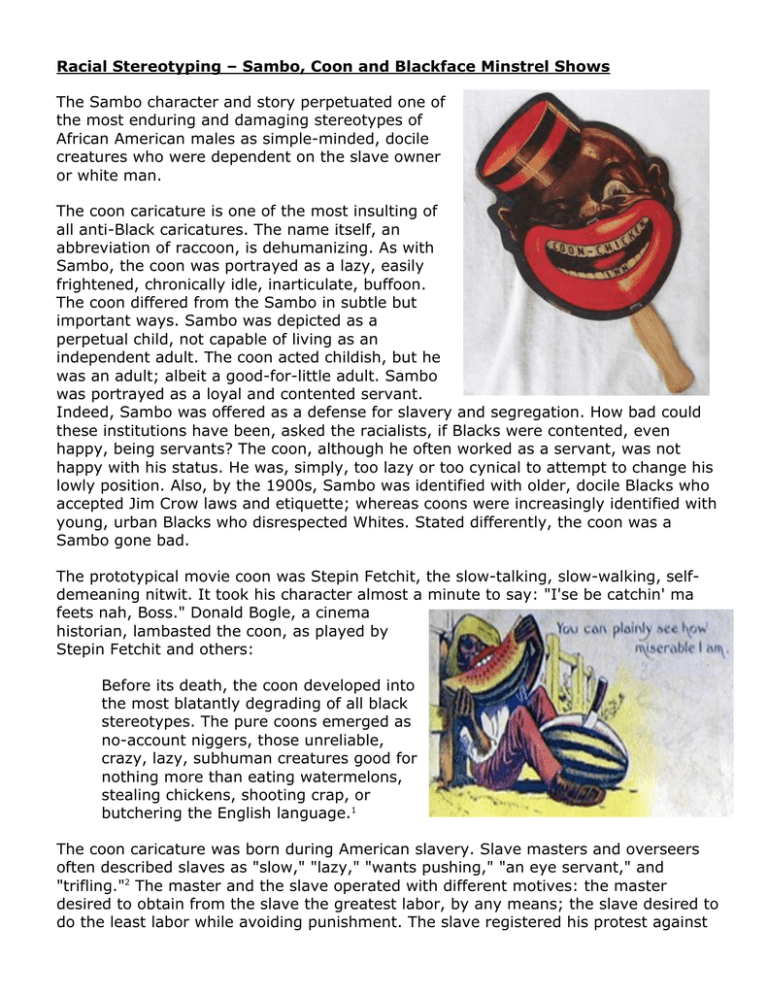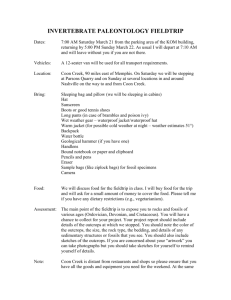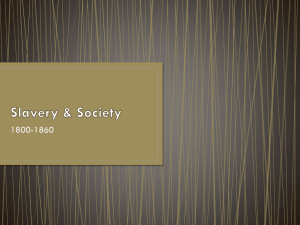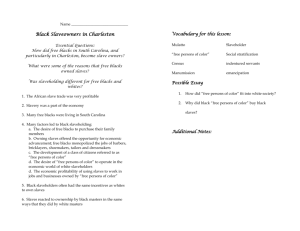Racial Stereotyping – Sambo, Coon and Blackface Minstrel Shows
advertisement

Racial Stereotyping – Sambo, Coon and Blackface Minstrel Shows The Sambo character and story perpetuated one of the most enduring and damaging stereotypes of African American males as simple-minded, docile creatures who were dependent on the slave owner or white man. The coon caricature is one of the most insulting of all anti-Black caricatures. The name itself, an abbreviation of raccoon, is dehumanizing. As with Sambo, the coon was portrayed as a lazy, easily frightened, chronically idle, inarticulate, buffoon. The coon differed from the Sambo in subtle but important ways. Sambo was depicted as a perpetual child, not capable of living as an independent adult. The coon acted childish, but he was an adult; albeit a good-for-little adult. Sambo was portrayed as a loyal and contented servant. Indeed, Sambo was offered as a defense for slavery and segregation. How bad could these institutions have been, asked the racialists, if Blacks were contented, even happy, being servants? The coon, although he often worked as a servant, was not happy with his status. He was, simply, too lazy or too cynical to attempt to change his lowly position. Also, by the 1900s, Sambo was identified with older, docile Blacks who accepted Jim Crow laws and etiquette; whereas coons were increasingly identified with young, urban Blacks who disrespected Whites. Stated differently, the coon was a Sambo gone bad. The prototypical movie coon was Stepin Fetchit, the slow-talking, slow-walking, selfdemeaning nitwit. It took his character almost a minute to say: "I'se be catchin' ma feets nah, Boss." Donald Bogle, a cinema historian, lambasted the coon, as played by Stepin Fetchit and others: Before its death, the coon developed into the most blatantly degrading of all black stereotypes. The pure coons emerged as no-account niggers, those unreliable, crazy, lazy, subhuman creatures good for nothing more than eating watermelons, stealing chickens, shooting crap, or butchering the English language.1 The coon caricature was born during American slavery. Slave masters and overseers often described slaves as "slow," "lazy," "wants pushing," "an eye servant," and "trifling."2 The master and the slave operated with different motives: the master desired to obtain from the slave the greatest labor, by any means; the slave desired to do the least labor while avoiding punishment. The slave registered his protest against slavery by running away, and, when that was not possible, by slowing work, doing shoddy work, destroying work tools, and faking illness. Slave masters attributed the slaves' poor work performance to shiftlessness, stupidity, desire for freedom, and genetic deficiencies. The amount of work done by a typical slave depended upon the demands of individual slave owners and their ability to extract labor. Typically, slaves worked from dawn to dusk. They were sometimes granted "leisure time" on Saturday or Sunday evenings; however, this time was spent planting or harvesting their own gardens, washing clothes, cooking, and cleaning. A slave owner wrote: "I always give them half of each Saturday, and often the whole day, at which time...the women do their household work; therefore they are never idle."3 Slave owners complained about the laziness of their workers, but the records show that slaves were often worked hard -- and brutally so. Overseers were routinely paid commissions, which encouraged them to overwork the slaves. On a North Carolina plantation an overseer claimed that he was a "'hole hog man rain or shine," and boasted that the slaves had been worked "like horses." He added, "I'd ruther be dead than be a nigger on one of these big plantations."4 After the closing of the African slave trade, the price of slaves went up, thereby causing some slave owners and their hired overseers to be more careful in their use of slaves. "The time had been," wrote one slave owner, "that the farmer could kill up and wear out one Negro to buy another; but it is not so now. Negroes are too high in proportion to the price of cotton, and it behooves those who own them to make them last as long as possible."5 Slaves are generally associated with the harvest of cotton; however, slaves worked in many industries. Almost every railroad in the ante-bellum South was built in part by slave labor. Slaves worked in sawmills, fisheries, gold mines and salt mines. They were used as deck hands on river boats. There were slave lumberjacks, construction workers, longshoremen, iron workers, even store clerks. Slaves monopolized the domestic services. Some slaves worked as skilled artisans, for example, shoemakers, blacksmiths, carpenters, mechanics, and barbers. These artisans were generally treated better than the slaves in the cotton and tobacco fields; therefore, it is not surprising that the artisans did better work. They included "many ingenious Mechanicks," claimed a White colonial Georgian, "and as far as they have had opportunity of being instructed, have discovered as good abilities, as are usually found among [White] people of our Colony."6 The supporters of slavery claimed that Blacks were a childlike people unequipped for freedom. Proslavers acknowledged that some slave masters were cruel, but they argued that most were benevolent, kind-hearted capitalists who civilized and improved their docile Black wards. From Radical Reconstruction to World War I, there was a national nostalgia for the "good ol' darkies" who loved their masters, and, according to the proslavers, rejected or only reluctantly accepted emancipation. In this context, the conceptualization of the coon was revised. During slavery almost all Blacks, especially men, were sometimes seen as coons, that is, lazy, shiftless, and virtually useless. However, after slavery, the coon caricature was increasingly applied to younger Blacks, especially those who were urban, flamboyant, and contemptuous of Whites. Thomas Nelson Page, a White writer wrote this in 1904: Universally, they [White Southerners] will tell you that while the old-time Negroes were industrious, saving, and when not misled, wellbehaved, kindly, respectful, and selfrespecting, and while the remnant of them who remain still retain generally these characteristics, the "new issue," for the most part, are lazy, thriftless, intemperate, insolent, dishonest, and without the most rudimentary elements of morality....Universally, they report a general depravity and retrogression of the Negroes at large in sections in which they are left to themselves, closely resembling a reversion to barbarism. 7 At the beginning of the 1900s many Whites supported the implementation of Jim Crow laws and etiquette. They believed that Blacks were genetically, therefore permanently, inferior to Whites. Blacks were, they argued, hedonistic children, irresponsible, and left to their own plans, destined for idleness -- or worse. It was not uncommon for Whites to distinguish between Niggers (Coons and Bucks) and Negroes8 (Toms, Sambos, and Mammies), and they preferred the latter. Racial caricatures are undergirded by stereotypes, and the stereotyping of Blacks as coons continued throughout the 20th Century. The pioneer study of racial and ethnic stereotyping in the United States was conducted in 1933 by Daniel Katz and Kenneth Braley, two social scientists. They questioned 100 Princeton University undergraduates regarding the prevailing stereotypes of racial and ethnic groups. Their research concluded that Blacks were consistently described as "superstitious," "happy-go-lucky," and "lazy." The respondents had these views even though they had little or no contact with Blacks.9 This study was repeated in 1951, and the negative stereotyping of Blacks persisted.10 The Civil Rights Movement improved Whites' attitudes toward Blacks, but a sizeable minority of Whites still hold traditional, racist views of Blacks. An early 1990s study conducted by the National Opinion Research Center found that the majority of the White, Hispanic, and other non-Black respondents displayed negative attitudes towards Blacks. For example, 78 percent said that Blacks were more likely than Whites to "prefer to live off welfare" and "less likely to prefer to be self-supporting." Further, 62 percent said Blacks were more likely to be lazy; 56 percent said Blacks were violence-prone; and 53 percent said that Blacks were less intelligent than Whites.11 Stated differently: the coon caricature is still being applied to Blacks. Martin Gilens, a Yale University political scientist, argued that many White Americans believe that Blacks receive welfare benefits more often than do Whites and that "the centuries old stereotype of blacks as lazy remains credible for a large number of white Americans." He claimed that opposition to welfare programs results from misinformation and racism, with Whites assuming that their tax money is being used to support lazy Blacks. Gilens blames, in part, the media. "Pictures of poor blacks are abundant when poverty coverage is most negative, while pictures of non-blacks dominate the more sympathetic coverage."12 The coon caricature was one of the stock characters among minstrel performers. Minstrel show audiences laughed at the slow-talking fool who avoided work and all adult responsibilities. This transformed the coon into a comic figure, a source of bitter and vulgar comic relief. He was sometimes renamed "Zip Coon" or "Urban Coon." If the minstrel skit had an ante-bellum setting, the coon was portrayed as a free Black; if the skit's setting postdated slavery, he was portrayed as an urban Black. He remained lazy and goodfor-little, but the minstrel shows depicted him as a gaudy dressed "Dandy" who "put on airs." Unlike Mammy and Sambo, Coon did not know his place. He thought he was as smart as White people; however, his frequent malapropisms and distorted logic suggested that his attempt to compete intellectually with Whites was pathetic. His use of bastardized English delighted White audiences and reaffirmed the then commonly held beliefs that Blacks were inherently less intelligent. The minstrel coon's goal was leisure, and his leisure was spent strutting, styling, fighting, avoiding real work, eating watermelons, and making a fool of himself. If he was married, his wife dominated him. If he was single, he sought to please the flesh without entanglements. Hollywood films extended the brutalization inherent in the coon image. The first cinematic coon appeared in Wooing and Wedding of a Coon (1905), a stupendously racist portrayal of two dimwitted and stuttering buffoons. Several notable slapstick "coon shorts" were produced in 1910-1911, including How Rastus Got His Turkey (he stole it) and Chicken Thief. In the blackface comedy Coon Town Suffragettes (1914), a group of domineering mammies organize a "movement" to keep their good-for-nothing husbands at home. These early coons laid the foundation for the "great" movie coons of the 1930s and 1940s. In the 1929 Fox film Hearts in Dixie, Chloe is married to Gummy, a "languid, shiftless husband whose 'mysery' in his feet prevents him from being of any earthly good as far as work is concerned, although once away from his wife's eye he can shuffle with the tirelessness and lanky abandon of a jumping jack."13 Chloe dies of swamp fever, and Gummy remarries. The new wife is portrayed as a shrew because she tries to force Gummy to work. This movie was a comedy, and most of the humor centered around Gummy's attempts to avoid work and his coon dialogue, for example, "I ain't askin you is you ain't. I is askin you is you is." The actor who played Gummy was Stepin Fetchit, the "greatest" coon actor of all time. Stepin Fetchit was born Lincoln Theodore Perry on May 30, 1892. A medicine show and vaudeville performer, he arrived in Hollywood in the 1920s. Perry claimed that he got the name Fetchit from a racehorse that won him money. However, he also told an interviewer that he came to Hollywood as a member of a comedy team know as "Step and Fetch It," and later adopted a variant of the name. His first featured movie role using the name Stepin Fetchit was in MGM's In Old Kentucky (1929). Whether as Gummy, Stepin Fetchit, or other names, he essentially performed the same role: the arch-coon. Daniel J. Leab, a cinema historian, said this: Fetchit became identified in the popular imagination as a dialect-speaking, slumpshouldered, slack-jawed character who walked, talked, and apparently thought in slow motion. The Fetchit character overcame this lethargy only when he thought that a ghost or some nameless terror might be present; and then he moved very quickly indeed.14 Fetchit was the embodiment of the nitwit Black man. As with the Zip Coon and Urban Coon, this old-fashioned coon character could never correctly pronounce a multisyllabic word. He was portrayed as a dunce. In Stand Up and Cheer (1934), he was tricked into thinking that a "talking" penguin was really Jimmy Durante. Fetchit, scratching his head, eyes bulging, portrayed the coon so realistically that Whites thought they were seeing a real racial type. His coon portrayal was aided by his appearance. According to Donald Bogle, a film historian: His appearance, too, added to the caricature. He was tall and skinny and always had his head shaved completely bald. He invariably wore clothes that were too large for him and that looked as if they had been passed down from his white master. His grin was always very wide, his teeth very white, his eyes very widened, his feet very large, his walk very slow, his dialect very broken.15 Fetchit's coon characters were racially demeaned and often verbally and even physically abused by White characters. In David Harum (1934) he was traded to Will Rogers along with a horse. He was traded twice more in the movie. In Judge Priest (1934), he was pushed, shoved, and verbally berated by Will Rogers; even worse, his character was barely intelligible, scratched his head in an apelike manner, and followed Rogers around like an adoring pet. In Black communities, Stepin Fetchit remains a synonym for a bowing and scraping Black man. In 1970 he sued CBS unsuccessfully for $3 million, charging defamation of character for the way he was portrayed in the television documentary Black History: Lost, Stolen, or Strayed. "It was Step," he claimed, "who elevated the Negro to the dignity of a Hollywood star. I made the Negro a first-class citizen all over the world...somebody it was all right to associate with. I opened all the theaters."16 That statement is hyperbole; however, Stepin Fetchit was a talented actor who added depth -- albeit, slight -- to the movie coon's portrayal. What is his legacy? He was the first Black actor to receive top billing in movies, and one of the first millionaire Black actors. He spawned imitators, most notably, Willie Best (Sleep 'n Eat) and Mantan Moreland, the scared, wide-eyed manservant of Charlie Chan. In 1978 he was elected to the Black Filmmakers Hall of Fame. But he will always be remembered as the lazy, barely literate, self-demeaning, White man's Black. He attempted a comeback in the 1950s, but it was unsuccessful; his coon caricature then seemed merely embarrassing. In the late 1960s he converted to the Black Muslim faith. In 1999 Fetchit's name was again in the headlines. Star Wars: Episode I-The Phantom Menace included a character named Jar Jar. Critics claimed that Jar Jar, a bumbling dimwitted amphibian-like character, spoke Caribbean-accented pidgin English, and had ears that suggested dreadlocks. Wearing bellbottom pants and vest, Jar Jar looked like the latest in Black cinematic stereotypes. Newspaper editorials and internet chat room discussions repeatedly invoked Stepin Fetchit's name. For example, Joe Morgenstern of the Wall Street Journal described Jar Jar as a "Rastafarian Stepin Fetchit on platform hoofs, crossed annoyingly with Butterfly McQueen."17 This incident suggests that Fetchit's legacy is to be remembered as a coon caricature: lazy, bewildered, stammering, shuffling, and good-for-little except buffoonery. © Dr. David Pilgrim, Professor of Sociology Ferris State University Oct., 2000 1 Donald Bogle, Toms, Coons, Mulattoes, Mammies, & Bucks: An Interpretive History of Blacks in American Films. (New York: Continuum, 1973/1994), p.8. 2 For an excellent discussion of the work environment of slaves read, Kenneth M. Stamp, The Peculiar Institution: Slavery in the Ante-Bellum South. (New York: Random House, 1956), Chapter 3. 3 Ibid, pp.79-80. 4 Ibid, p.85. 5 Ibid, p.81. 6 Ibid, p.63. 7 Thomas Nelson Page, The Negro: The Southerner's Problem. (New York: Charles Scribner's Sons, 1904), p. 80. 8 Note the lower case "n" in Negro. For years, as a sign of disrespect, White writers refused to capitalize the "n." 9 Daniel Katz and Kenneth Braley. 1933. "Racial Stereotypes of One Hundred College Students," Journal of Abnormal and Social Psychology, Vol. 28, pp. 280-290. 10 G.M. Gilbert. 1951. "Stereotyping Persistence and Change Among College Students," Journal of Abnormal and Social Psychology, Vol. 46, pp. 245-254. 11 Lynne Duke, "But Some of My Best Friends Are...," The Washington Post. January 14-20, 1991. Found on the internet: http://members.aol.com/digasa/stats1.htm. 12 Martin Gilens, Why Americans Hate Welfare. (Chicago: University of Chicago Press), 1999. 13 Daniel J. Leab, From Sambo to Superspade: The Black Experience in Motion Pictures. (Boston: Houghton Mifflin, 1976), p.86. 14 Ibid, p. 89. 15 Bogle, op. cit. p. 41. 16 Ibid, p.44. 17 Michael Fleeman, "Jar Jar Must Die." An Associated Press article found at http://www.beachbrowser.com/Archives/eVoid/June-99/Jar-Jar-Must-Die.htm Questions for Thought: 1) What are some of the racial stereotypes these images are trying to reinforce? 2) What physical features are characteristic of the Sambo/Coon caricature? 2) Why was it important for whites to perpetuate these stereotypes? 3) How have these racial stereotypes endured today?



